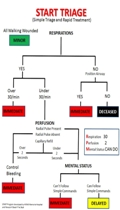It's not hard to make decisions when you know what your values are. - Roy Disney
Simple triage and rapid treatment (START) is a triage method used to quickly classify victims during a mass casualty incident (MCI) based on the severity of their injury. There are four common categories used to evaluate and classify victims.
- Immediate (red)
- Delayed (yellow)
- Minor (green)
- Expectant/Deceased (black)
The colors above correspond to triage tags, which are used by some agencies to indicate each victim's status, although physical tags are not necessary if patients can be physically sorted into different areas. When performing triage during a MCI you may choose to ask that any victim who is able to walk relocate to a certain area, thereby identifying the ambulatory, or minor patients. Non-ambulatory patients can then be assessed. After all patients have been evaluated, the START classifications can be used to determine priorities for treatment or evacuation to a hospital.
Classifications
Immediate
Patients who categorized as immediate should be transported first. Examples of injury that would classify a patient as immediate include Systolic blood pressure of <90, respiratory rate of <10 or >29 breaths per minute (<20 in infant aged <1 year), or need for ventilatory support, uncontrolled or severe bleeding, signs of shock, severe burns, a decreased level of consciousness and open chest or abdominal injuries.
Delayed
Patients who are categorized as delayed need treatment and transport; however it can be temporarily be delayed. Examples of injuries that would classify a patient as delayed include burns without airway problems, major or multiple joint injuries, and back injuries with or without spinal cord damage.
Minor
Patients who are categorized as minor are commonly referred to as "walking wounded". These patients require minimal or no treatment, and transport can wait until higher priority patients have been treated and transported first. Examples of injuries that would classify a patient as minor include minor fractures and soft tissue injuries.
Expectant
Patients who are categorized as expectant include those who are obviously dead, in cardiac arrest, are in respiratory arrest or have injures that are obviously non survivable. The only medical intervention used prior to declaring a patient deceased is an attempt to open the airway. Any patient who is not breathing after this attempt is classified as deceased and given a black tag. No further interventions or therapies are attempted on deceased patients until all other patients have been treated.

Flowchart of START Triage
Ethics of Triage
The decisions to limit life-or-death treatments can be a difficult one to make when performing triage, and are even more difficult for the patient to understand. Patients are understandably selfish and short-sighted regarding their own care. Both provider and patient can feel that triage is immoral. When triage is viewed relative to the situation, the ethical principles that guide triage are evident.


